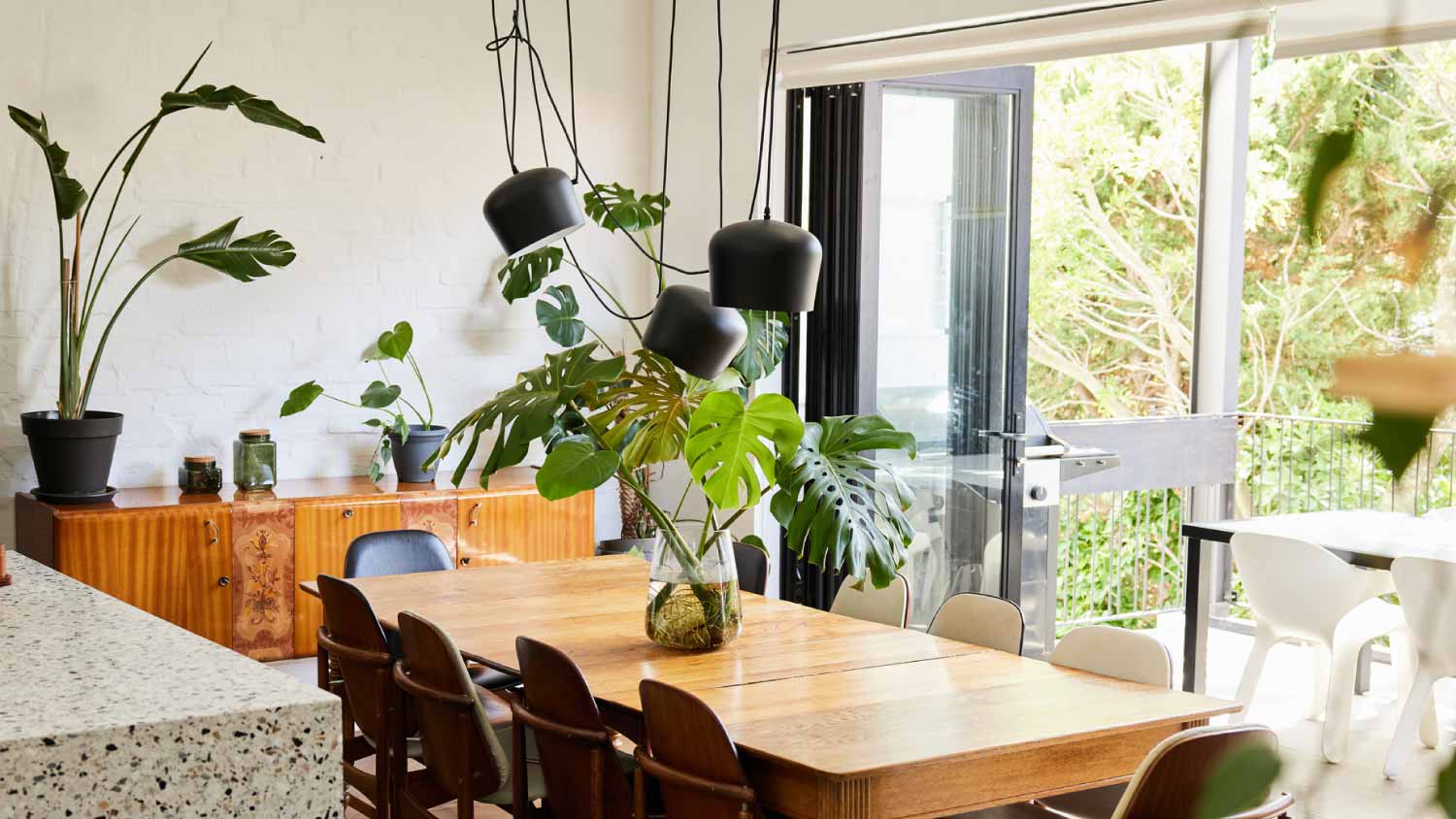6 Types of Pendant Lights To Consider in Your Lighting Plan
Size isn't everything, but it sure matters in lighting


Are you ready to add pendant lights to your lighting plan? Pendant lights come in a range of sizes and shapes, and knowing the best way to use them in your space is easy when you follow a few simple guidelines. We've made a list of pendant light types and summarized some important things to consider while you're planning.
What Is Pendant Lighting?
Pendant lighting is one of the many types of lighting available for the home. It comes in countless designs: with or without shades, plain or embellished, facing up or down, multi-light or single.
What makes it a pendant light? It hangs from the ceiling like a chandelier rather than sitting flush. However, chandeliers are tiered with multiple lights stemming from a single source.
What Are The Key Elements Of Pendant Lighting?
In general, pendant lights consist of a canopy, downrod or chain, and a socket. Many pendant light fixtures have bulb-specific sockets for different types of light bulbs. From there, the theme, shade shape or style, and type mix and match for a veritable bevy of options.
Have a look at some of the options available to you in the world of pendant lighting.
| Type | Theme | Shade Shape |
|---|---|---|
| Single Bulb | Art Deco | Bowl |
| Down Facing | Bohemian | Cylinder |
| Inverted/Shade Up | Coastal | Disc |
| Lantern | Contemporary | Drum |
| Linear/Multi-light | Farmhouse | Dome/Cone |
| One Canopy | Industrial | Globe/Sphere |
1. Single Bulb
A single-bulb pendant is one of the most versatile styles. Though minimalist at its core, the bulb is the star here. Use this type of pendant to showcase a specialty bulb like an LED Edison or an oversized globe bulb. Choose a glass shade in any shape, from cylinder to teardrop, and any finish, including smoky, pigmented, etched, and textured.
| Pros | Cons |
|---|---|
| Minimalist look | Can be harsh light |
| Hardware highlights | No focus to the light |
| Easy to clean | Not for large spaces |
Best For: Decorative lighting
2. Down Facing

A down-facing pendant light has a domed drum or cone shade that directs the light down with either a wide angle or narrow focus. With this type of pendant, the shade is where it's at. Choose a Tiffany-style shade with ornate multicolored glasswork, an industrial look with black metal, or soften the style with a rattan weave shade.
| Pros | Cons |
|---|---|
| Many shade choices | Light is too focused |
| Many bulb choices | Size limitations |
| Easy to clean | Not for small spaces |
Best For: Focused lighting
3. Inverted/Bowl Shade
This type of pendant light is the cousin to the downward shade but flipped. The shade shape is that of a bowl. It completely covers the bulb, creating a diffused and general light. A swirled frosted white glass with brushed nickel creates a contemporary look, or choose a cream hue with ornate floral embossment and oil-rubbed bronze hardware for an antique feel.
| Pros | Cons |
|---|---|
| Ambient light | Not focused |
| Shade options | Hard to clean |
| Light bulb choices | Not for small spaces |
Best For: Hallways
4. Lantern
Perhaps the most specific of the types is the lantern. This pendant light is caged like the lanterns of yesteryear. It makes a perfect accent to a mudroom or any protected outdoor space. If you use it outdoors, make sure it's rated for the weather, and choose one with rod tubing rather than rope or chain, so it doesn't swing in the wind.
| Pros | Cons |
|---|---|
| Industrial look | Location-specific |
| General lighting | Limited options |
| Light bulb choices | Can be harsh light |
Best For: Foyer or patio
5. Linear/Multi-light

The linear pendant light uses one or two downrods and one hood or frame with multiple lights in a line. This type is a great option if you want more than one pendant light but don't want to wire multiple fixtures. It comes in downward, inverted, and lantern styles. Choose a wood cage frame with single bulbs for a rustic farmhouse look.
| Pros | Cons |
|---|---|
| One fixture | Harder to clean |
| Lights a wide area | Limited options |
| Versatile light | Not for small spaces |
Best For: Above a dining table or island
6. Multi-Light, One Canopy
The multi-light pendant is similar to the linear type in that you only need to wire for one fixture to get multiple pendants. With this type, multiple pendants hang from one canopy. This way, you can adjust the height of each pendant individually to add interest to the piece. Choose black cylinder shades for an industrial look or glass and goldtone for Old Hollywood glam.
| Pros | Cons |
|---|---|
| One fixture | Limited options |
| Dramatic light | Not for small spaces |
| Good in large spaces | Harder to clean |
Best For: Above an island or open floor plan dining table
Choosing the Right Size Pendant Light
There isn’t a minimum size a pendant light should be, but there is a maximum: It shouldn’t dominate the area. Try to keep at least six inches of space from the edge of the light to the perimeter of your table, island, or vanity. If you have a 36-inch round table, the maximum size of your pendant shade is 24 inches.
Things change when you add more than one pendant to the plan. Allow for the six-inch perimeter buffer and 18 inches between each light.
Choosing the Right Pendant Light Height
If you’re hanging your pendant light over a table, island, or another piece of furniture, hang it about 30” to 36'' above the surface measuring from the lowest point of the pendant. You want to be able to see the rest of the room and your guests without the lights blocking you.
In a general space like a hallway or foyer, the height of the light should be about six-and-a-half to seven feet from the floor. The key point is to hang it high enough that no one will bump into it but low enough that it hangs as a pendant rather than a ceiling light.
Positioning and Grouping Smaller Pendant Lights
These guides can help you with big pendant lights, but you have more flexibility if you choose smaller pendants.
Plan from the center point of the length of your space. Work along the length as you add your pendants. Two pendants should hang equidistant from the center, observing the six-inch perimeter rule. More pendants in even numbers follow similar rules—equidistant from each other and the center point. For an odd number of pendants, start with one in the center and space them equidistant from that point.
Don’t forget to have fun with it. Pendant lights are versatile: They can be fairly inexpensive and are easy to swap out once you know what you’re doing.
Frequently Asked Questions
Pendant lights make a worthy addition to your home lighting, and you can find them in almost every style. The average cost to install a light fixture is $550, and labor is the highest cost. You can DIY a light fixture replacement in an afternoon and save a couple of hundred dollars, depending on the fixture. If you’re not confident working with electrical components, an electrician in your area can easily install your pendant lighting for you.
You can install pendant lights almost anywhere you would install a ceiling light. Shade-up or bowl pendants are great anywhere you want ambient light. Shade-down lights can add focused light to any location. Pendant lights complement common types of kitchen lighting, like recessed lights and chandeliers. They also look great over a bar, pool table, or vanity.





- What Is a Pendant Light? Everything You Need To Know To Brighten Up Your Space
- Pendant Size Chart: Keys To Choosing the Right Fit
- 15 Dining Room Lighting Ideas to Brighten Your Space
- What Are the Best Types of Light Fixtures To Install in Your Home?
- How to Choose the Best Types of Kitchen Lighting for Your Home
- 20 Deck Lighting Ideas to Brighten Up Your Outdoor Living Space
- 4 Common Types of Light Bulbs: A Complete Guide
- 6 of the Best Types of Porch Lights to Illuminate Your Space
- Types of LED Light Bulbs—What’s Right for Your Space?
- Ready for Your Big Closet Reveal? Illuminate Your Space With These Lighting Ideas First










